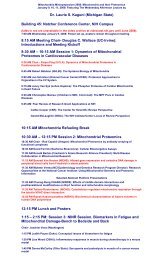RESEARCH ON THE FETUS - National Institutes of Health
RESEARCH ON THE FETUS - National Institutes of Health
RESEARCH ON THE FETUS - National Institutes of Health
Create successful ePaper yourself
Turn your PDF publications into a flip-book with our unique Google optimized e-Paper software.
procedure, however, would be questionable. Based on prior experience with the<br />
inconsistencies <strong>of</strong> placental passage <strong>of</strong> any agent, the human situation would<br />
remain unknown after any amount <strong>of</strong> animal testing. Testing in the human is<br />
still required even after negative results in animal models, with the same<br />
safeguards as if no animal testing had been conducted.<br />
The second alternative would be to wait for the accidental vaccination<br />
<strong>of</strong> pregnant women and observe the outcome. This in fact occurred in several<br />
instances after the planned testing. The women involved, who had wanted pregnancies,<br />
elected instead to terminate their pregnancies by abortion due to the<br />
risk to the fetus, and studies <strong>of</strong> tissue from the dead fetuses confirmed that<br />
they had been infected by the virus. Thus, the effect in humans could have been<br />
learned in this instance by retrospective research. At issue here in the selection<br />
<strong>of</strong> alternatives is the question whether it is preferable to proceed by<br />
design with women planning abortions, or to work retrospectively with women who<br />
desire pregnancy but were accidentally vaccinated.<br />
2. The use <strong>of</strong> amniocentesis (removal <strong>of</strong> amniotic fluid via a needle<br />
inserted into the uterus through the mother's abdomen) as a clinical procedure<br />
dates from 1882, when it was introduced as a treatment for polyhydramnios (excess<br />
accumulation <strong>of</strong> amniotic fluid). There is no evidence that animal studies were<br />
conducted prior to that time, and comparatively little research has been done on<br />
amniocentesis as a procedure apart from its applications. The Battelle study <strong>of</strong><br />
amniocentesis thus involved evaluation <strong>of</strong> the uses to which the procedure has<br />
been put, as well as alternative means for developing the procedure. Amniocentesis<br />
has found application in three main areas <strong>of</strong> research: prenatal diagnosis<br />
<strong>of</strong> genetic disease, diagnosis <strong>of</strong> Rh disease, and assessment <strong>of</strong> fetal maturity<br />
related to respiratory distress syndrome. Its use in the latter two areas will<br />
be discussed in parts 3 and 4 <strong>of</strong> this section.<br />
Two lines <strong>of</strong> research provided impetus for prenatal diagnosis <strong>of</strong> genetic<br />
disease: development <strong>of</strong> the technology for tissue culture and identification <strong>of</strong><br />
the sex chromatin as an indicator <strong>of</strong> sex in single cells. In 1955 it was shown<br />
that fetal sex could be predicted from the sex chromatin pattern <strong>of</strong> amniotic<br />
fluid cells. Application <strong>of</strong> this technique to prenatal detection <strong>of</strong> sex-linked<br />
disorders was first reported in 1960. Rapid progress in tissue culture research<br />
19











